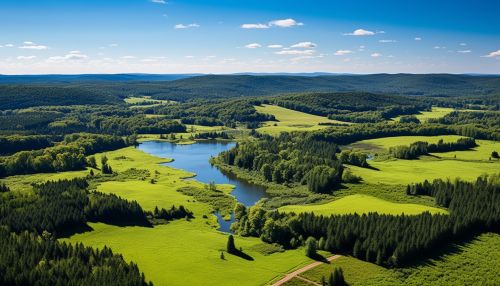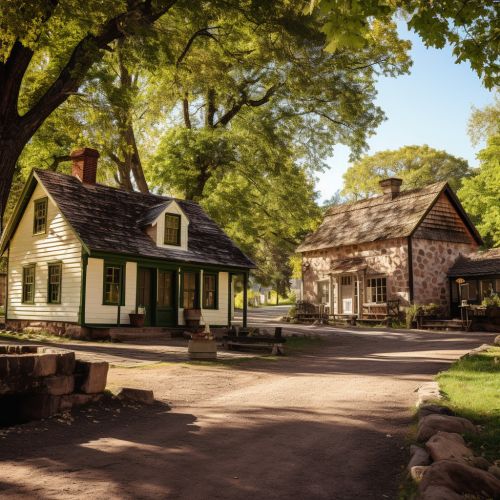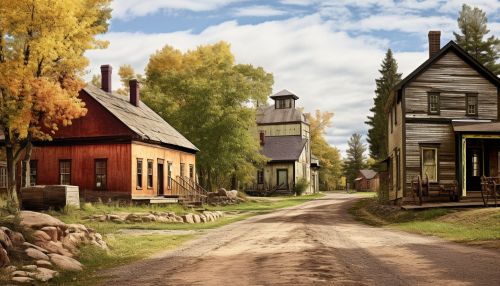Minnesota
Geography
Minnesota is a state in the Midwest and Northern regions of the United States. It is the 12th largest state by area, covering approximately 86,939 square miles (225,180 km2). Minnesota is bordered by Wisconsin to the east, Iowa to the south, South Dakota and North Dakota to the west, and the Canadian provinces of Ontario and Manitoba to the north. The state's highest point is Eagle Mountain at 2,301 feet (701 m), which is only 13 miles (21 km) away from the lowest point of 602 feet (183 m) at the shore of Lake Superior.


Minnesota's climate varies widely, owing to its size and geographical location. The state experiences four distinct seasons, with long, cold winters and warm to hot, often humid summers. The state is known for its severe weather, from thunderstorms with tornadoes to blizzards.
History
The history of Minnesota is characterized by the early arrival of indigenous people, followed by European exploration and settlement, territorial growth, and eventual statehood. The earliest known inhabitants were the Dakota, who were followed by the Ojibwe and other tribes. The first Europeans to arrive were French fur traders in the 17th century, followed by settlers from New England and other parts of the U.S. in the 19th century.


Minnesota became a U.S. territory in 1849 and was admitted as the 32nd state on May 11, 1858. The state played a key role in the American Civil War, particularly with the 1st Minnesota Volunteer Infantry, and later in the industrial development of the United States.
Economy
Minnesota's economy is one of the largest and most diversified in the United States. It is known for its high standard of living and strong job market. The state's economy is based on services, manufacturing, trade, transportation, and utilities, with significant contributions from health care, education, and government. Major industries include food production, machinery, mining, and tourism.


Minnesota is a leading state in annual farm income. It ranks at or near the top among all states in the production of corn and soybeans. Minnesota's mineral wealth includes vast amounts of iron ore, but the state is also a major producer of granite and other stones.
Demographics
As of the 2020 census, Minnesota had a population of approximately 5.7 million people. The state's population is predominantly white, but it has a growing diversity. Minnesota has the largest Somali and Hmong populations in the U.S., and a significant Native American population. The state's population is concentrated in the Minneapolis-Saint Paul metropolitan area, also known as the "Twin Cities," which is home to approximately 60% of Minnesotans.


Culture
Minnesota's culture is a blend of indigenous, northern European, and modern American influences. The state is known for its civic participation and high voter turnout, and it has a strong tradition of public education. Minnesota is also known for its love of the outdoors, with a high participation in outdoor activities such as hunting, fishing, and boating.


Minnesota has made significant contributions to music, literature, and theater, with notable individuals such as Bob Dylan, F. Scott Fitzgerald, and the Coen Brothers hailing from the state. The state is also home to a vibrant food scene, with a strong emphasis on local and sustainable ingredients.
See Also
- History of Minnesota
- Geography of Minnesota
- Economy of Minnesota
- Demographics of Minnesota
- Culture of Minnesota
References
- ↑ Minnesota State Demographic Center. (2020). Minnesota Population Projections. Retrieved from https://mn.gov/admin/demography/data-by-topic/population-data/our-projections/
- ↑ United States Department of Agriculture. (2019). Minnesota State Agriculture Overview. Retrieved from https://www.nass.usda.gov/Quick_Stats/Ag_Overview/stateOverview.php?state=MINNESOTA
- ↑ Minnesota Historical Society. (n.d.). Minnesota History Timeline. Retrieved from https://www.mnhs.org/history/mn-timeline
